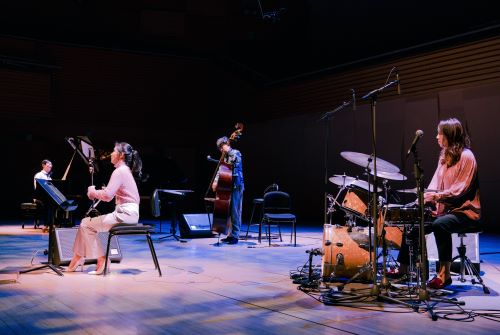Haegeum Player Kim Dan-bee

Kim Dan-bee, a talented haegeum player based in Gwangju, has built a career by following her own path in both music and life. Embracing the haegeum’s distinctive sound, she has explored a wide range of creative endeavors, spanning from performance to production and pushing the boundaries of traditional music while remaining rooted in her own unique artistic identity. The Chonnam Tribune visited her studio on Oct. 8 to gain insight into her journey.
Her Journey with the Haegeum
The haegeum, a two-stringed fiddle classified as a bow string instrument, produces sound by rubbing horsehair on strings positioned between a resonating body. Kim’s connection to the haegeum began in middle school. "One day, I came home and found a haegeum that my father, a traditional musician, had brought home," she recalled. "Coincidentally, my school started offering after-school haegeum lessons around that time, and that is when I began to explore the instrument." What started as a casual interest grew into a passion, leading her to pursue a career in music. "The haegeum allowed me to express myself naturally, with its raw, textured sound contrasting with the smoothness of other string instruments."
Unlike many traditional musicians who specialize in a single instrument during college, Kim majored in music education, gaining experience with a wide variety of instruments. “In this major, students learn not just Western music, but also popular music, western drums, janggu (Korean drum), and more. I may not be an expert in all of these techniques, but having a broad understanding has been a huge advantage for me. What I learned through my major has been an invaluable asset.”

Performing in Gwangju
While many artists tend to believe that moving to Seoul or the capital region is necessary to find more opportunities for success, Kim has a different perspective. “I don’t have any desire to move to Seoul,” she said, explaining that the high population density and living costs in the region hold no appeal for her. “I enjoy living in Gwangju and traveling to other regions for my work in music.”
Despite her enthusiasm for the city as a whole, she expressed concern about Gwangju’s lack of interest in traditional music. “Refined musical tastes and a culture of artistic appreciation have not become widespread in Gwangju. As someone who wants to continue working here, I feel these challenges deserve serious consideration.”
To contribute to Gwangju’s musical environment, Kim has actively organized and participated in various performance projects, including “Happy Companionship” and “Threshold 2024.” The latter, launched in July 2023, focuses on enhancing artists’ self-sustainability and promoting collaboration. Through these projects, she has been committed to expanding her creative reach while contributing to the local arts scene. “There are many free exhibitions and performances in Gwangju and near CNU. I hope more people take advantage of them,” she noted, wishing to bring art closer to daily life.
Expanding Musical Horizons
Kim has steadily expanded her musical boundaries in each of her albums. For her first two albums, she did everything herself, from illustrating covers to composing and writing essays. On her third album, she focused on jazz, releasing crossover tracks which blended it with other genres. “As I continued performing, I realized I needed my own music. That is how I started composing. And I have always liked jazz, so I decided to give it a try.”
Despite exploring various genres, traditional Korean music remains the core of Kim’s artistic identity. She acknowledges the challenges of balancing it with modern genres. “Working with traditional Korean music differs from collaborating through genres like jazz. The approaches to sheet music and performance are distinct, making communication with musicians from other musical backgrounds challenging.”
Kim also expressed her desire to explore other traditional Korean and global music styles. “I love Korean and international folk songs. They are resilient, full of energy in both their melodies and their lyrics. I am currently working on some folk music projects. Moreover, I want to collaborate with other forms as well.”
Empowering Students Through Music
One of Kim’s significant contributions to the traditional music community is her work with a content factory called NALab (No Answer Laboratory). Founded to document traditional musicians’ activities, NALab offers a variety of educational videos and performance recordings, aimed at making traditional music more accessible. “I want to create videos that are educational and helpful, so seeing comments from young students saying they found our videos useful—it’s cute and makes me proud,” she shared.
NALab’s YouTube channel and blog feature traditional music performances, updates on upcoming events, and instructional videos covering instruments such as the danso (bamboo flute) and the gayageum (stringed zither). These resources preserve the art form while inspiring future generations with practical guidance.
At the end of the interview, Kim encouraged university students to explore their passions without hesitation. "You never know if something is right for you until you try. College days are great time to experiment and find out what you truly enjoy." Kim herself took this approach when she founded Leadingtone, an educational performing group, during her university years. The group, which continues to perform today, aims to make music education more dynamic and engaging. "The experiences you gain by stepping out of your comfort zone will stay with you for a long time," she added.
By Oh Hyun-ju, Editor

